Leeds Drug and Alcohol Strategy: 2025-2030
Foreword
We are delighted to present the Leeds Drug & Alcohol Strategy 2025-30.
We are grateful to the people who gave us their time and honesty in sharing how drugs and alcohol affect their lives. Leeds is a diverse city and people from different communities told us what they thought needed to be in our strategy to feel that it truly reflected them.
In this strategy, our first priority places us firmly upstream in preventing harms from occurring through reducing exposure to drugs and alcohol, using our regulatory powers where necessary, to ensure Leeds is a healthy place to live, learn, play, and work.
We are extremely proud of our outstanding drug and alcohol treatment and recovery services, and the city has benefitted from additional national investment. We want to continue to support our treatment and recovery services to thrive and grow. We are proud to be part of the Inclusive Recovery Cities movement with a vibrant and growing offer of activities by small, independent, lived experience recovery organisations (LEROs) and peer support in the city.
However, the Leeds Drug & Alcohol Strategy is wider than treatment and recovery. Hearing stories from young people in Leeds reinforced our commitment to do more to prevent drug and alcohol exposure and harms, working together with our partners and communities themselves. Our consultation repeatedly identified trauma and poor mental health as individual and family risk factors at the root of substance use and offending, and we want to ensure there is early and effective help for those affected to avoid further harms.
Neighbourhoods in Leeds which are already facing challenges of social deprivation are disproportionately impacted by the social harms of substance use including crime, anti-social behaviours and drug and alcohol litter. We need to work together to ensure that our communities feel safe and protected from drug and alcohol harms.
We have chosen six priorities for the next 5 years, supported by an action plan and governance to ensure we make progress towards achieving them. We believe that these are the right priorities, informed and supported by the people of Leeds.

Victoria Eaton.
Director of Public Health, Leeds City Council
Chair of the Leeds Drug and Alcohol Partnership Board
Contents
Foreword
Our Vision
Introduction
Why have a Drug and Alcohol Strategy?
What are we going to do?
Priority 1: Prevention
Priority 2: Harm Reduction
Priority 3: Treatment and support
Priority 4: Social and community harms from substance use
Priority 5: Children, young people and families
Priority 6: Recovery
How will we implement the strategy and achieve our vision?
Equality, Diversity and Inclusion
How will we review progress?
Acknowledgements
References
Our Vision:
Leeds is a compassionate city that works with individuals, families, and communities to prevent drug and alcohol harms and to provide outstanding treatment and recovery support

Introduction
Like all large cities in the UK, Leeds is impacted by the health and social harms of drug and alcohol use. This document describes our plans for addressing these harms across the life course, covering children, young people and adults, and takes a trauma-informed approach.
Our vision supports the Best City Ambition for Leeds, with a mission to tackle poverty and inequality and improve quality of life for everyone who calls Leeds home. It supports wider ambitions set out in the Leeds Health and Wellbeing Strategy, the Safer Leeds Community Safety Strategy, and The Healthy Leeds Plan. The success of this strategy will contribute to achieving our city priorities, including ensuring that Leeds is the best city for Health and Wellbeing, a Child-Friendly City and contributes to safe, strong, families and communities, a Marmot City, a Fast Track City, and an Inclusive Recovery City.
This strategy supports the national priorities, ambitions and challenges of the Government’s 10-year drugs plan, From Harm to Hope (2021), informed by Dame Carol Black’s independent review of drug harms.
We have worked collaboratively with partners across the city to agree our vision and the priorities and commitments to achieve this. Development of this strategy has been informed by engagement with a wide range of people and organisations, including young people, professionals, people engaging in treatment services and those in recovery, carers and community groups. We will continue to work effectively with our partners, stakeholders and service users to deliver the strategy and review our progress.
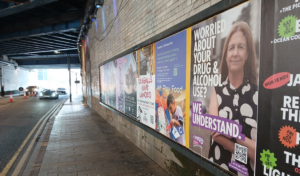
Why have a Drug and Alcohol Strategy?
Drug and alcohol use affects a large number of people – not just those who use drugs and alcohol but also their families, loved ones, carers, wider communities, and services and businesses in the city.
The consequences of drug and alcohol use for people and society are wide ranging and can be long lasting. Our vision is that Leeds is a compassionate city that works with individuals, families and communities affected by drug and alcohol use to help them to make better and more informed choices, and lead healthier, safer, and happier lives. An important element of the strategy is around minimising drug and alcohol harms and preventing associated problems from escalating.
As a Marmot City, we recognise the role of social inequalities and social exclusion in creating a less fair society where some people die younger and live more years of their lives in poor health. Substance users – who are sometimes also sex workers, prisoners, rough sleepers – experience extreme social exclusion and this strategy is for them, to make their lives better, and through this we make our city better.
“Socially excluded populations: the homeless, people with substance use disorders, sex workers, and prisoners… can seem to be off the scale of the social hierarchy completely…” Michael Marmot
The national context
In December 2021, the Government published a 10-year drugs plan. It set out 3 priorities:
-
-
- Break drug supply chains, so that law enforcement agencies can target and prevent the drug-related causes of crime effectively, reducing the associated violence and exploitation of people and reducing supply of drugs
- Deliver a world-class treatment and recovery system which provides those experiencing, or at risk of experiencing, drug and alcohol issues the treatment and support they need to achieve long-term recovery; including support to achieve more stable life outcomes for those experiencing multiple disadvantages
- Achieve a generational shift in the demand for drugs by building an evidence base, encouraging adults to change their behaviours and preventing young people from starting to take drugs.
-
The plan recognises that local government and partners are best placed to establish local priorities and work collaboratively to address these challenges quickly and effectively. New investment has resourced local partners to deliver results and reduce drug-related harm.
The local context
The Leeds Drug and Alcohol Partnership (LDAP) has been established to provide oversight and ensure the delivery of comprehensive treatment and recovery programmes, alongside effective enforcement and ambitious prevention, to reduce drug and alcohol harms in the city. The Partnership is a collaboration between key agencies including Public Health, Safer Leeds, the NHS, Police, Prisons, Probation, Children’s Services and the third sector, with involvement of people with lived experience.
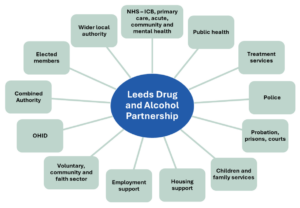
Forward Leeds, the city’s all-age, integrated drug and alcohol service is a Care Quality Commission “Outstanding” rated service that supports adults and young people affected by drug and/or alcohol use. Significant additional national funding for drugs and alcohol has enabled the service to expand and increase the number of adults and young people in treatment, engage with people facing disadvantage and additional health needs, and improve the proportion of people leaving prison engaging in treatment.
The number of adults who successfully completed treatment, in 2023/24, is higher in Leeds than the national average for all four categories (opiate; alcohol only; alcohol and non-opiate; and non-opiate only), with Leeds the best performing Core City for successful completions of opiate treatment.
However, like all local authorities, Leeds faces challenges – from attracting and retaining the drug and alcohol workforce to responding to new emerging issues such as synthetic opioids and reducing high rates of drug-related deaths.
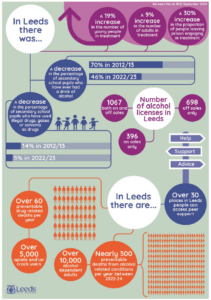
The infographic above contains this information:
In Leeds between March 2022 and September 2024 there was:
A 19% increase in the number of young people in treatment
A 9% increase in the number of adults in treatment
A 30% increase in the proportion of people leaving prison engaging in treatment
A decrease in the percentage of secondary school pupils who have ever had a drink of alcohol, from 70% in 2012/13 to 46% in 2022/23
A decrease in the percentage of secondary school pupils who have used illegal drugs, gases or solvents as drugs, from 14% in 2012/13 to 5% in 2022/23
There are 1067 on and off sales licences in Leeds
There are 698 off sales only licences
There are 396 on sale licences
In Leeds there are over 30 places people can access peer support
In Leeds there are over 60 preventable drug related deaths per year
In Leeds there are over 5,000 opiate and / or crack users
In Leeds there are over 10,000 alcohol dependent adults
In Leeds there are nearly 300 preventable deaths from alcohol related conditions per year between 2022 and 2024
What are we going to do?
Priority 1: Prevention
Neighbourhoods in Leeds will be healthy spaces and people will be protected from drug and alcohol exposure and harms.
Priority 2: Harm Reduction
Fewer people in Leeds will experience drugs and/or alcohol harms – where people use drugs and/or alcohol they make better, safer, and informed choices.
Priority 3: Treatment and support
More people in Leeds who are in need will be supported by drug and alcohol treatment services.
Priority 4: Social and community harms from substance use
People in Leeds will not be victimised, exploited, or be victims of crime and disorder associated with drugs and/or alcohol.
Priority 5: Children, young people and families
Children and young people in Leeds are protected from drug and alcohol harms and supported towards bright futures.
Priority 6: Recovery
Leeds is an inclusive recovery city, where we are ambitious about recovery, and recovery is visible and celebrated.
When we use the term “we” throughout this strategy we mean the Leeds Drug and Alcohol Partnership, which is our city’s Combatting Drugs Partnership.
When we say “people told us” and “we heard” we mean the Leeds City Council Drug & Alcohol Team officers who carried out the consultation.
Priority 1: Prevention
Neighbourhoods in Leeds will be healthy spaces and people will be protected from drug and alcohol exposure and harms.
Why is this important?
People told us that they were regularly exposed to drugs and alcohol and associated harms. We heard about visible drug dealing and drug and alcohol use in neighbourhoods and the city centre. Some young people were worried about being targeted for recruitment by gangs in local parks. It has become a social norm to smoke and vape cannabis in public and Leeds residents want this to change.
Neighbourhoods which are already experiencing higher levels of social deprivation also tend to have a high number of off licensed premises, adding to the local availability of alcohol. For people living in these areas, it is often not a “free choice” to be involved in alcohol or drug use and young people may be at risk due to these exposures. Some neighbourhoods experience rough sleeping, begging, drinking on the street and street sex work.
“When I get off the school bus and walk up the park, I’m seeing people smoking drugs and I’m scared because what are they capable of? It makes me feel upset” – Young person
What makes a difference?
Reducing and managing exposure to alcohol in the places where people live, go to school, work and socialise can mitigate and reduce alcohol harms. We know that exposure to alcohol advertising leads to underage drinking and drinking at binge and hazardous levels, and alcohol advertising can also lead to cravings and presents a risk to people in recovery. There is evidence that young adults drink more in areas where there are more licensed premises. Self-regulation by the alcohol industry has been shown to be ineffective; evidence-based policies to reduce alcohol-related harms include Public Health as an alcohol Licensing Objective, Minimum Unit Price, alcohol harms labelling and advertising restrictions.
We will:
-
-
- Use our regulatory powers as a local authority on licensing and planning to address the negative impacts of drugs and alcohol on neighbourhoods.
- Raise awareness of evidence-based policies to reduce alcohol-related harms.
- Work with local partners, including trusted community organisations and West Yorkshire Police, to reduce the impact of drug and alcohol harms on communities and prevent further exposure to harms.
-
Priority 2: Harm Reduction
Fewer people in Leeds will experience drugs and/or alcohol harms – where people use drugs and/or alcohol they make better, safer, and informed choices.
Why is this important?
Our priority is to keep people in Leeds as safe and well as possible, so we offer support to reduce the harms associated with drug and alcohol use.
People told us that social and cultural norms on drugs and alcohol need to change to achieve a generational shift in preventing young people starting to use drugs/alcohol, in the same way that attitudes towards smoking have changed and we can begin to see a smokefree generation. People told us that the dangers of alcohol were not as well-known as the dangers of drugs and that this needs to change. Many people do not realise they are drinking alcohol at a level that is harmful to their health and are not fully aware of the health harms of alcohol when consumed at this level, including liver disease, brain damage, and cancer, including breast and bowel cancer.
“My drug worker kept me alive long enough to be ready for recovery” – Man in recovery
What makes a difference?
High-quality alcohol education, information and campaigns such as ‘Dry January’ can increase awareness of alcohol harms. They should be offered alongside alcohol control policies (e.g. licensing) to reduce alcohol consumption. It is important to identify alcohol harm early, for example through alcohol screening in primary care, and provide brief advice, support and treatment as appropriate.
Harm reduction services, including vaccination, screening and needle exchange, reduce the risk of blood-borne virus transmission and other harms. Evidence-based overdose prevention policies and services include the provision of naloxone to reduce the risk of overdose.
We will:
-
-
- Increase awareness of drug and alcohol harms through education, information and campaigns.
- Increase early identification and appropriate intervention for alcohol-related harms, including liver disease.
- Ensure the availability of high-quality harm reduction services, including screening and vaccination for blood borne viruses, needle exchange and overdose prevention.
-
Priority 3: Treatment and support
More people in Leeds who are in need will be supported by drug and alcohol treatment services.
Why is this important?
Our priority is to ensure that people in Leeds continue to have access to inclusive, high-quality treatment and support services for drugs and alcohol.
People with lived experience told us that it is important to take a person first, compassionate approach to substance use. Treatment and support should acknowledge trauma and mental health, with understanding that substance use is rarely a choice. They explained that you cannot separate substance use from mental health, emotional regulation and emotional resilience, calling for a greater focus on this and equipping the whole Leeds workforce to support people with their mental health. It is important that we work together to address any barriers experienced by people with protected characteristics or facing multiple disadvantage.
“We are not defined by our past, we have choices and can decide who we want to be now and in the future, my worker helped me choose who I wanted to be” – Person in recovery
What makes a difference?
There is a strong evidence base for effective drug and alcohol treatment, including a combination of psychological, pharmaceutical and mutual aid approaches. Supporting people to engage in alcohol treatment can be challenging and effective approaches include addressing stigma, family and peer support, good relationships with treatment staff, and addressing structural barriers such as time and money. Services need to provide a wide range of options for support to meet the varied individual needs of people who could benefit and provide support in a way that is sensitive to people’s culture and background. They need to be accessible to all, addressing barriers to access at individual (e.g. fears and beliefs about treatment, co-occurring mental health conditions), social (e.g. stigma and lack of social support) and structural (e.g. effective pathways between GP, hospital, prison, treatment) levels.
We will:
-
-
- Ensure treatment services are high quality and effective.
- Provide a wide and varied number of treatment options that are responsive to need.
- Ensure treatment is accessible and inclusive to all communities, with effective pathways and outreach provision.
- Support families and carers of people in treatment and recovery services in their own right
- Increase the capacity and competency of the drug and alcohol workforce.
-
Priority 4: Social and community harms from substance use
People in Leeds will not be victimised, exploited, or be victims of crime and disorder associated with drugs and/or alcohol.
Why is this important?
People who use drugs and alcohol are vulnerable to exploitation and often victims of crime. People talked about drug and alcohol users being unsafe in their own homes due to having their homes taken over by gangs (“cuckooing”), being sexually exploited in “trap houses”, and being victims of domestic abuse. Vulnerable children and young people in Leeds are at risk of exploitation by criminal groups. The impacts of substance use on the extremely vulnerable are seen daily in the city of Leeds through street behaviours such as rough sleeping, begging, street drinking, and street sex work.
A significant amount of crime in the city is linked to funding drug and alcohol use or the organised crime that supplies demand for drugs. People with lived experience of substance-related offending and professionals told us that more needs to be done to support adults leaving prison and young people leaving the secure estate.
We heard that it is important to protect Leeds’ well-deserved reputation as an attractive place to live, work, and invest in and reduce the negative impact of substance use on the business and retail sector. Leeds has a vibrant night-time economy. It is important to ensure that this is safe and enjoyable for everyone, and that people are protected from drug and alcohol harms.
“People are not in a good place on release from prison, due to lack of support, broken system, lack of opportunities they go back to addiction.” – Person in recovery
What makes a difference?
Structured interventions are effective for young people and adults at high risk of substance use-related offending, alongside addressing underlying issues such as mental health. Partnership working between the local authority, police, prisons and probation, the voluntary and community sector, health and wider partners is required to prevent drug and alcohol-related crime and disorder and ensure that people feel safe. This is particularly important to ensure that people in the criminal justice system with drug and alcohol needs receive the support they need. Leeds lived experience recovery organisations should be key partners in this work.
We will:
-
-
- Prioritise the protection of vulnerable adults from drug and alcohol-related exploitation.
- Protect children and young people from drug and alcohol-related criminal exploitation.
- Tackle serious and organised crime associated with drugs, including county lines.
- Address offending and antisocial behaviour associated with drug and alcohol use and improve outcomes for offenders.
- Address the availability and harm caused by illicit drugs and the inappropriate availability of alcohol.
- Address drug and alcohol-related violence against women and girls.
-

Priority 5: Children, young people and families
Children and young people in Leeds are protected from drug and alcohol harms and supported towards bright futures.
Why is this important?
We asked people in recovery to look back at how their substance use journeys started and tell us what would help in protecting young people in Leeds. They explained that substance use and mental health in young people were strongly linked. They told us that we need to have honest conversations about substance use with young people, particularly those with parents with substance use issues. There should be safe places in schools and communities for young people and their parents to talk about drugs, alcohol, and mental health.
Young people told us about being exposed to drugs and alcohol in school, at home, in parks, in their neighbourhoods, and on social media. Some had strategies to resist becoming involved in substance use, but others felt scared at being drawn in. Young people we spoke to felt able to talk to family, youth groups, and the police who link into the youth groups, but did not trust schools as places to disclose worries about substance use. This is not the experience of all young people in Leeds, but it should concern us that this is the experience of any young person in Leeds. Youth groups and faith groups were central to young people feeling able to resist substance use.
We heard about the role of parental substance use in child safeguarding and the long-term impacts on children. Children and young people who are care-experienced, and children with Special Educational Needs and Disabilities (SEND) may be at greater risk of developing difficulties. It is also crucial to prevent, detect and provide support for those impacted by Foetal Alcohol Spectrum Disorder (FASD).
“I feel like I will get pulled in. I feel scared” – Young person
What makes a difference?
Risk factors for children and young people developing substance use problems include individual level (impulsivity, frustration and anger, emotional regulation, screen time), family level (adverse childhood experience, substance-using family members, poor supervision by parents, pocket money), and community (e-cigarette exposure, drug accessibility, having peers who use drugs). Protective factors include individual (optimism, mindfulness, strong beliefs against substance use, the desire to be healthy), family (family awareness of drug use, strong mother-child relationships, family cohesion, educational achievement) and community level (school connectedness, structured activity).
To protect children and young people from drug and alcohol harms we need to prioritise emotional resilience, family cohesion, school connectedness, structured activities, and work with faith communities. Early and better advice and support (early help) for families experiencing challenges with substance use can play an important role in preventing trauma and improving outcomes.
We will:
-
-
- Ensure children and young people understand the potential harms of drugs and alcohol and how to be online safely.
- Support children and young people’s self-confidence, emotional resilience, and mental wellbeing to increase their potential to resist substance use.
- Protect children and young people with substance-using parents/carers from further harms supporting Family Drug & Alcohol Courts to protect children and care for families
- Ensure children and young people are supported to access services for their drug and/or alcohol use.
- Ensure there are safe places and trusted people in every neighbourhood for young people to discuss their concerns around substance use and receive support.
- Recognise care as a locally protected characteristic and young people in or leaving care as needing particular support
-
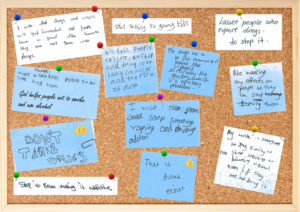
The image above shows words of children and young people in Leeds, they read as follows:
“I wish that drugs and alkols will get bannded and people have a good life because they are not gonna use drugs”
“Stop selling to young kids”
“Locate people who export drugs, to stop it”
“God helps people not to smok and alcol”
“to tell people online to stop and doing it of lung cancier and the risk of deth”
“For drugs not to be so normalised against the people especially the youth which is especially prevalent”
“No wasting any efforts on peope so they can stop taking them”
“I wish that people could stop smoking vaping and drinking alchol”
“DONT TAKE DRUGS”
“Stop it from making it addictive”
“That it didnt exist”
“My wish is for everyone in my family to not start smoking or drinking alcohol even if they are not doing it”
Priority 6: Recovery
Leeds is an inclusive recovery city, where we are ambitious about recovery, and recovery is visible and celebrated.
Why is this important?
Recovery is a journey which often starts in treatment services and then continues in communities in Leeds.
People in recovery told us how important social connection with other people in recovery is in community spaces such as recovery cafes, art and music groups, running and climbing groups, and mutual aid. People from diverse communities, including faith-based and LGBTQ+, told us that it was important to have recovery spaces and activities within those communities so that recovery does not mean having to withdraw from your own community.
Recovery organisations help people to maintain their own recovery, through meaningful social connection and activity, and make recovery visible to those still in active substance use. Lived Experience Recovery Organisations (LEROs) are key to creating a social movement for recovery and are often embedded in their local communities providing visible recovery and confidence in recovery, as well as social impact.
“You need something to give a glimmer of hope. [Visible recovery] is about giving people hope – they can’t even conceive it as a possibility ever, not drinking, and I was like that, and it was speaking to someone who had recovered…” – Woman in recovery
What makes a difference?
Recovery often involves constructing a new identity from someone who uses substances to someone who is abstinent: recovery communities and mutual aid can help with that process by providing the essential building blocks to establishing a person’s true self, without substances. Recovery support services, which may be lived experience-led, peer-peer, housing-based, have been shown to be effective at preventing relapse, building personal recovery capital and enabling sustained recovery. Community-based recovery support should run alongside treatment and continue after treatment is over.
We will:
-
-
- Support Lived Experience Recovery Organisations to grow the social movement for recovery in Leeds so that it reaches all neighbourhoods and communities, including our diverse communities.
- Grow the number of volunteer recovery champions, celebrate recovery and spread messages of hope.
- Involve people with lived experience in training the health and wider workforce to support a compassionate approach.
-
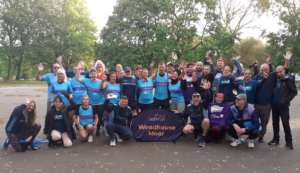
How will we implement the strategy and achieve our vision?
This is a strategy for the whole city to adopt and we want partners to actively contribute to delivering the strategy and action plan.
The LDAP will oversee the delivery of the strategy and monitor progress. The strategy will be supported by a joint action plan to drive change against our 6 priorities and commitments. Members of the Partnership will be responsible for different areas of the action plan and will be accountable to the Partnership for the delivery. We will review the action plan, annually, to take stock of what we have achieved and set future actions.
We recognise the importance of close working with partners, including NHS organisations, Voluntary, Community, Faith and Social Enterprise organisations and enforcement agencies, to develop a shared, citywide approach. This will ensure that services (including mental and physical health, criminal justice, housing and employment and skills) are better integrated and able to address the challenges of drug and alcohol use.
‘The Best City Ambition’ describes our collective efforts as stakeholder to achieve our shared vision of improving quality of life and achieving inclusive economic growth for Leeds. #TeamLeeds is one way in which we work together to achieve that ambition. In Leeds, approximately 57,000 people work in health and care. Our skilled and passionate staff work together as one health and social care team ‘#TeamLeeds’, to improve outcomes for the people of Leeds, and to strengthen the support available to our staff. Our strategic partners on the Leeds Drug and Alcohol Partnership Board and our drug and alcohol workforce, both paid and volunteer, are part of #TeamLeeds.
In addition, we value the work being done across West Yorkshire and the wider region, and are committed to working collaboratively with partners in other areas.
In order to deliver this strategy, we will ensure that we:
-
-
- Work as part of #TeamLeeds to deliver the Best City Ambition and the three pillars, health and wellbeing, economic growth, and zero carbon
- Listen to and involve people with lived experience
- Use the best available evidence, data, and intelligence to inform decisions
- Focus on prevention
- Are ambitious for recovery
- Are trauma informed/aware
- Challenge stigma of those who use drugs and/or alcohol
- Work with vulnerable people, including those who are not currently accessing services
- Work restoratively, using a ‘Think Family’ approach and remain alert to current and emerging safeguarding issues
- Have a “child-first” focus, viewing children and young people as victims of crime in need of safeguarding and supporting into safer, better, futures
- Are aware of new and emerging issues and respond quickly and effectively
- Encourage innovation and the use of new technologies
- Seek additional funding opportunities through business, private enterprise, and academia to support this agenda.
-
Equality, Diversity and Inclusion
Leeds is a vibrant and diverse city. It is our priority to ensure that this strategy meets the needs of people from different backgrounds, those with protected characteristics and those facing disadvantage, stigma or additional health challenges.
There is limited data and recent high-quality evidence on drug and alcohol needs among people with protected characteristics, although there is some evidence of higher needs in transgender young people and adults, older adults, people with ADHD, and people with mood disorders. People from marginalised communities may also face additional challenges in accessing treatment and support.
What did people in Leeds tell us about their experiences?
We met with faith communities and equalities groups to understand what was important to include in a Leeds Drug & Alcohol Strategy from their perspective.
Communities facing stigma and oppression have a high level of self-medication. Services need to be very sensitive and bespoke. If you live in a community, you don’t want everyone knowing your business…” – Member of Leeds City Council Race Equality Staff Network
We heard about the importance of engaging faith communities in prevention of substance use, challenging stigma and taboos and improving access to services and support and the need for two-way learning between treatment services and faith communities. Different approaches are needed to meet the needs of different age groups including better information for people aged over 50 and for workforce development around healthy ageing, drugs and alcohol.
Shame, stigma, and oppression are powerful factors in minoritised communities using substances and can create barriers to getting help. Treatment and recovery workforce cultural competence is key to improve access to services and quality of care. Structural barriers to treatment identified in engagement included affordable, safe, and suitable transport, childcare to attend appointments, and physically accessible services. Safety is a key consideration for women who would like more women-focussed and women-only treatment and recovery sessions.
“People self-medicate for mental health issues, because they are unable to get mental health treatment. My husband was an alcoholic, and he died. He drank to deal with emotional pain, and services were inadequate.” – Disabled woman, Leeds
Women and LGBTQ+ people told us about feeling unsafe in the night-time economy, and LGBTQ+ people told us about the need for safe, social, sober space to be themselves.
“I’ve been sober 2 years and it’s been more difficult to interact with our community. There are limited places that I feel comfortable going to as a sober LGBTQ+ person”. – Leeds LGBTQ+ Hub member
Leeds recognises care experience as a protected characteristic and we are committed to brighter futures for all young people, including those in care and leaving care.
It was particularly concerning that young black men we spoke to had very low self-esteem and confidence, telling us that they would have nothing to contribute and this was notably very different to other young men from other ethnic backgrounds.
We will continue to work with the Leeds Drug and Alcohol Partnership during the lifetime of this strategy to ensure equality, diversity, inclusion is a central strand to our work.

How will we review progress?
A monitoring framework will be developed to monitor progress on our 6 priorities and action plan, in collaboration with partners. The LDAP will regularly review and report on progress to the Health and Wellbeing Board, Safer Leeds Executive and Children and Young People’s Partnership.
We will continue to engage with communities and listen to the voice of lived experience and people with protected characteristics.
Through implementation of this strategy, we hope to improve understanding of drug and alcohol use and harms in the city to ensure that we can respond appropriately.
The strategy will contribute towards the National Combatting Drugs Outcome Framework, local alcohol outcomes and other local priority outcomes, including:
-
-
- Reduced drug and alcohol use
- Reduced drug and alcohol-related crime
- Reduced drug and alcohol-related deaths and harm, including hospital admissions
- Reduced drug supply
- Increased engagement in drug and alcohol treatment
- Improved recovery outcomes.
-


Acknowledgements
We thank all those who contributed insights to the strategy, including Adults Health and Active Lifestyles Scrutiny Board, Adults & Health Directorate Leadership Team, Adult Social Care Strategy & Transformation, Leeds Drug & Alcohol Partnership and subgroups, LTHT Drug and Alcohol Healthcare Steering Group, Carers Leeds, Young Carers, Adults and Healthy Living Senior Leadership Team, Forward Leeds Art of Working Together group, Neighbourhood Improvement Board, Leeds Anti-Social Behaviour Team, His Majesty’s Prison Leeds Drug Strategy Lead and Group, BARCA and CATCH and the young people who shared their stories with us, Leeds City Council Staff Equalities Network Leads, Religion and Belief Board, Disabilities Hub, LGBTQ+ Hub, Safer Leeds Executive, Children and Young People’s Partnership Board, Leeds Health and Wellbeing Board.
References
Why have a Drug and Alcohol Strategy?
Black, C. (2020) Independent Review of Drugs by Dame Carol Black. Home Office and DHSC
Marmot, M. (2018). Inclusion health: addressing the causes of the causes. Lancet, 391(10117), 186–188. Inclusion health: addressing the causes of the causes – The Lancet
HM Government, (2021) From Harm to Hope: A 10-year drugs plan to cut crime and save lives.
Priority 1 Prevention
Finan, L.J, et al (2020) ‘Alcohol Marketing and Adolescent and Young Adult Alcohol Use Behaviours: A Systematic Review of Cross-Sectional Studies’, J Stud Alcohol Drugs Suppl, Mar;(19):42-56.
Foster, S. et al (2020) ‘Over the limit? Testing non-linear associations between alcohol outlets and young adults’ alcohol consumption’, Drug and Alcohol Review, Volume 39 (6), Pages 664-670.
Heenan, M. et al (2024) ‘Legal and regulatory instruments for NCD prevention: a scoping review and descriptive analysis of evaluations in OECD countries’, BMC Public Health 24, 641. https://bmcpublichealth.biomedcentral.com/articles/10.1186/s12889-024-18053-4
Kilian, C. et al (2023) ‘Reducing alcohol use through alcohol control policies in the general population and population subgroups: a systematic review and meta-analysis’, EClinicalMedicine, May 10;59:101996.
Langley, T. et al (2022) ‘The effect of alcohol marketing on people with, or at risk of, an alcohol problem: A rapid review’, European Journal of Public Health, 32. https://academic.oup.com/eurpub/article/32/Supplement_3/ckac131.327/6765401
Sargent, J.D., Babor, T.F. (2020) ‘The Relationship Between Exposure to Alcohol Marketing and Underage Drinking Is Causal’, J Stud Alcohol Drugs Suppl., Mar (19):113-124. https://www.jsad.com/doi/10.15288/jsads.2020.s19.113
Wyper, G.M. A. et al (2023) ‘Evaluating the impact of alcohol minimum unit pricing on deaths and hospitalisations in Scotland: a controlled interrupted time series study’, The Lancet, Vol 401 (10385), 1361 – 1370.
Zuckermann, A.M.E (2024) ‘The effects of alcohol container labels on consumption behaviour, knowledge, and support for labelling: a systematic review’, The Lancet Public Health, Vol 9 (7), e481 – e494.
Priority 2 Harm Reduction
Chimbar, L., Moleta, Y. (2018) ‘Naloxone Effectiveness: A Systematic Review’, J Addict Nurs. Jul/Sep;29(3):167-171.
de Ternay, J. et al (2022) ‘One-month alcohol abstinence national campaigns: a scoping review of the harm reduction benefits’, Harm Reduct J, Mar 4;19(1):24.
Manthey, J. et al (2023) ‘Improving alcohol health literacy and reducing alcohol consumption: recommendations for Germany’, Addict Sci Clin Pract, May 9;18(1):28.
Tonin, F.S, Alves da Costa, F., Fernandez-Llimos, F. (2024) ‘Impact of harm minimization interventions on reducing blood-borne infection transmission and some injecting behaviors among people who inject drugs: an overview and evidence gap mapping’, Addict Sci Clin Pract. Feb 4;19(1):9.
Priority 3 Treatment and support
Farhoudian, A. et al (2022) ‘Barriers and Facilitators to Substance Use Disorder Treatment: An Overview of Systematic Reviews’, Subst Abuse, Aug 29;16:11782218221118462.
Kelly, J. et al (2009) ‘How do people recover from alcohol dependence? A systematic review of the research on mechanisms of behavior change in Alcoholics Anonymous’ Addiction Research and Theory June. 17. 236-259.
McPheeters, M. et al (2023) ‘Pharmacotherapy for Alcohol Use Disorder: A Systematic Review and Meta-Analysis’, JAMA, Nov 7;330(17):1653-1665.
Perrin, S. et al (2024) ‘Exploring and describing alcohol harm reduction interventions: a scoping review of literature from the past decade in the western world’, Harm Reduct J, Nov 23;21(1):207.
Ray, L.A., et al (2020) ‘Combined Pharmacotherapy and Cognitive Behavioral Therapy for Adults With Alcohol or Substance Use Disorders: A Systematic Review and Meta-analysis’, JAMA Netw Open, 3(6)
Priority 4 Social and community harms
Baranyi, G. et al (2022) ‘The prevalence of comorbid serious mental illnesses and substance use disorders in prison populations: a systematic review and meta-analysis’, The Lancet Public Health, Volume 7, Issue 6, e557 – e568. https://www.thelancet.com/journals/lanpub/article/PIIS2468-2667(22)00093-7/fulltext
Macdonald, C. et al (2024)’ Interventions to reduce harms related to drug use among people who experience incarceration: systematic review and meta-analysis’, Lancet Public Health, Sep;9(9)
Saladino, V. et al (2021) ‘The Vicious Cycle: Problematic Family Relations, Substance Abuse, and Crime in Adolescence: A Narrative Review’, Front. Psychol. , Vol12. https://www.frontiersin.org/journals/psychology/articles/10.3389/fpsyg.2021.673954/full
Priority 5 Children and young people
Adamson, J., Templeton, L., Clifton, J. (2012) Silent Voices: supporting children and young people affected by parental substance misuse briefing on key themes and findings from the report. Available at: SILENT VOICES
Roy, J. (2024) ‘Parental substance misuse and statutory child protection in England: Risk factors and outcomes’. Child Abuse Review, 32(2), e2786. https://onlinelibrary.wiley.com/doi/10.1002/car.2786
Nawi, A.M., Ismail, R., Ibrahim, F. et al. (2021) Risk and protective factors of drug abuse among adolescents: a systematic review. BMC Public Health 21, 2088 https://bmcpublichealth.biomedcentral.com/articles/10.1186/s12889-021-11906-2
Priority 6 Recovery
Chen, G. (2024) ‘Identity Construction in Recovery from Substance Use Disorders’, J Psychoactive Drugs, Jan-Mar;56(1):109-116.
Day, E. et al (2025) ‘Recovery support services as part of the continuum of care for alcohol or drug use disorders’, Addiction.
Equality, Diversity and Inclusion
Choi, W.S., (2022) ‘The prevalence of psychiatric comorbidities in adult ADHD compared with non-ADHD populations: A systematic literature review’, PLoS One, Nov 4;17(11).
Connolly, D., Gilchrist, G. (2020) ‘Prevalence and correlates of substance use among transgender adults: A systematic review’, Addictive Behaviors, Vol 111,106544. https://www.sciencedirect.com/science/article/abs/pii/S0306460320306742?via%3Dihub
Fahey, K.M.L. et al (2023) ‘Substance use prevalence, patterns, and correlates in transgender and gender diverse youth: A scoping review’, Drug and Alcohol Dependence, Vol 250. https://www.sciencedirect.com/science/article/abs/pii/S0376871623011183?via%3Dihub
Jaqua, E.E et al (2022) ‘Substance Use Disorder in Older Adults: Mini Review’, Addict Health. Jan;14(1):62-67.
Ruppert, R., Kattari, S.K., Sussman, S. (2021) ‘Review: Prevalence of Addictions among Transgender and Gender Diverse Subgroups’, Int J Environ Res Public Health. Aug 22;18(16):8843.
Saha, S. et al (2022) ‘Comorbidity between mood and substance-related disorders: A systematic review and meta-analysis’, Aust N Z J Psychiatry, Jul;56(7):757-770.
